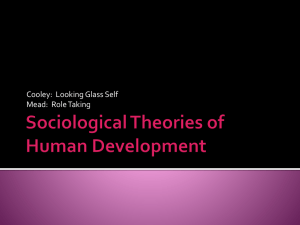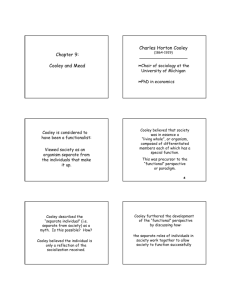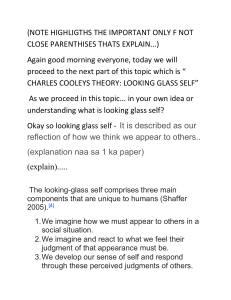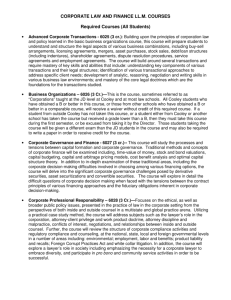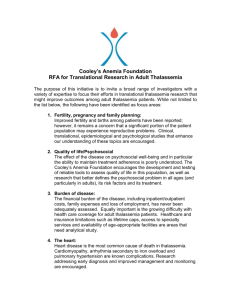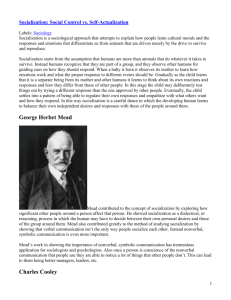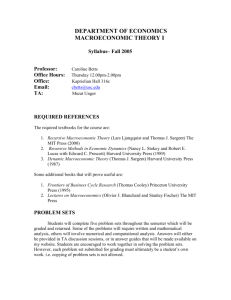Charles Cooley
advertisement
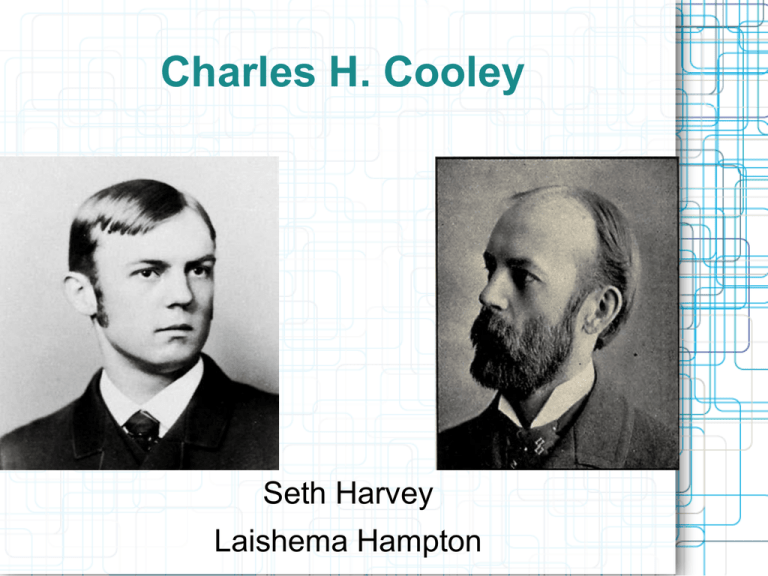
Charles H. Cooley Seth Harvey Laishema Hampton Charles Cooley 1864-1929 Born in Ann Arbor, MI Education • University of Michigan • Engineering In 1890 he married Elsie Jones • they had three children Background His father Thomas Cooley was a member of the Michigan Supreme Court • Charles struggled with living under the shadow of his famous father Cooley Taught at the University of Michigan He was concerned with many social problems and issues of the day, but clearly preoccupation with the self--his own self-remained paramount to him. He did become independent of his father--but his experience caused a desire to study the self and its relationship with society. This desire to observe behavior was later applied toward his own children. Intellectual Influences Charles Darwin Cooley’s holistic philosophy, his stress on interactions and interrelations, and his rejection of all types of atomistic interpretation in the study of man were deeply influenced by Darwin William James Derived the idea of the self from James’ Social Self Pragmatism “As a method, pragmatism hovered close to life, refusing to close the process of thought prematurerly, taking its cue from facts of life, willing to be led to new conceptions of purpose as deeper facets of human emotion and expectations were discovered.” Influences Continued Herbert Spencer The organic view of society “Nearly all of us who took up sociology between 1870, say, 1890, did so at the instigation of Spencer”-Cooley 1930 Life is progressive in nature William Sumner Groups In-groups and out-groups Methodology Displeased at the sociological communities division over methodology Empirical and observational Appreciated statistics but preferred case studies Often used own children as the subjects of his observations Major Works The Theory of Transportation (1894) Human Nature and the Social Order(1902) Concluded towns and cities tend to be located at major breaks in transportation routes Foreshadowed Mead’s work on the self by detailing the way social responses affect the emergence of social participation\ Social Organization(1909) Looking glass self Comprehensive approach to society Social Process(1908) Emphasis on the non-rational, tentative nature of social organization Significance of social competition Clash of primary group values(love, ambition, loyalty) and institutional values(ideologies) Society adjust to reach an equilibrium of the two values Social Organization(1909) A “sociological antidote” to Sigmund Freud First formulated the role of primary groups Society was a constant experiment in enlarging social experiences Concluded class differences reflect different contributions to society as well as the phenomena of exploitation Primary Groups Intimate, face-to-face association Fundamental to the development and continued adjustment of their members 3 basic primary groups Family Child’s play group Neighborhood or community among adults Almost universal among all societies Provide the earliest and most complete experiences of social unity Instrumental in the development of the social life Secondary Groups Anonymous, impersonal, and instrumental relationships Relationships are temporary and interchangeable. Choose to be part of instead of growing into it. Usually based on interest and activities Exchange of commodities ex. Labor for wages, service for payment... Looking Glass Self Formed and emerges in primary groups 3 key principles The imagination of our appearance to the other person. The imagination of their judgment of that appearance. Our resulting self-feeling, such as pride or mortification An individuals self image mirrors the imagined reactions of others to our appearance, demeanor, and behavior This drawing depicts the looking-glass self. The person at the front of the image is looking into four mirrors, each of which reflects someone else's image of him back to him. Looking Glass Self cont. Especially important when applied to children A child’s personality is plastic and malleable Children learn that their actions will cause reactions in others, especially their mothers. They learn to manipulate their environment, giving them a sense of power and control Limitations Our interpretation of the looking glass self varies from individual to individual

